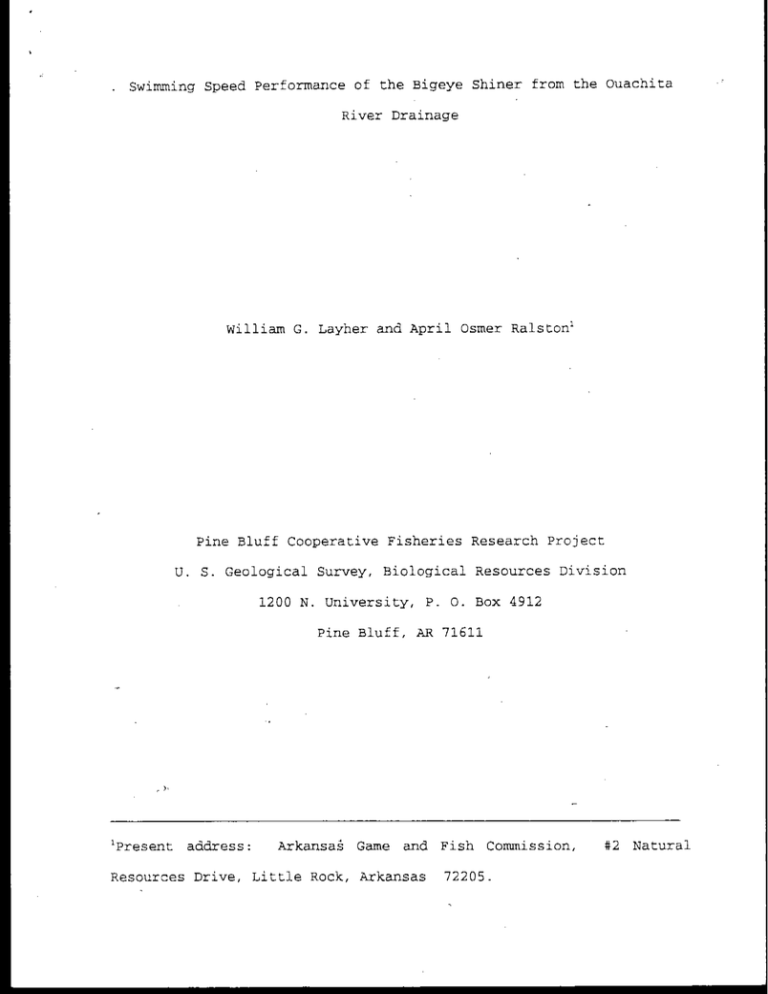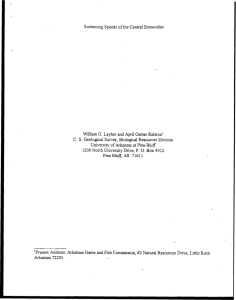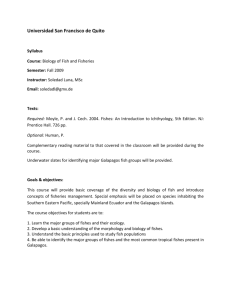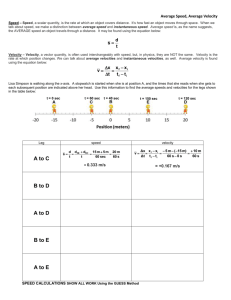Swimming the Ouachita River Drainage
advertisement

Swimming Speed Performance of t h e Bigeye Shiner from the Ouachita River Drainage William G. Layher and April Osmer ~alston' Pine Bluff Cooperative Fisheries Research Project U , S. Geological Survey, Biological Resources Division 1200 N. University, P. 0. Box 4912 Pine Bluff, AR 71611 - 'present . .. . address: Arkansai Game and Fish Commission, Resources Drive, L i t t l e Rock, Arkansas 72205. #2 Natural INTRODUCTION A p r o t e c t i o n of small streams and their associated fauna are of importance to land management agencies such as major Small streams provide habitat for endemic species Forest Service. in the Ouachita drainage such as the paleback darter , l .~ n r s u m ) a s mllld well as (Wwg other more distributionally widespread (Robison and Buchanan 1988) . species the U. S. Some of the species that occur in small streams, while found in other areas as well, are nevertheless important components of the streams ecosystem. Modification of streams can come i n a variety of forms ranging from channel alterations to land use practices Channel restrictions such as culverts can increase current runoff. causing d i f f i c u l t y velocities and reduce stream bottom roughness for affecting stream small fishes moving Theoretically this upstream. could eliminate ephemeral spawning grounds as well as recruitment into ephemeral drainages when conditions were more favorable for fishes. The velocities which small fishes can endure and for what periods of time are of special concern in de~ermiing impacts of structural stream alterations such as culverts. A of number studies have performed on been the swimming abilities of larger fishes ( e g . Thomas and Donahoo 1977; Buckley et al. 1985). Apparatus unsuitable for shiners. Much swimming used determining of abilities the often in each swimming of speeds literature on involve these small selection of studies appeared fishes fishes of such as related to - habitats in an artificial stream by fishes rather than assessing ability of the fish to successfully negotiate a current Matthews et a1 . 1990) . the bigeye shiner of known velocity (eg. In this study we determine the endurance of (Notronis b o n ~ s ) to select current velocities from low velocities to velocities which produce complete failure the fish to negotiate. MATERIALS AND METHODS Layher and Ralston found significant differences (1995 between swimming performance of small fishes coilected by seining and those collected by electrofishing. Consequently all fishes used in this study were collected by seining which was assumed to have no negative impact on the fishes swimming ability. collections of tributaries. housed fishes These were made the in provided collections Ouachita specimens in a controlled environment where oxygen and were held relatively constant. Several River which and were temperature Temperatures varied from 1 7 . 9 to 20.1 C and dissolved oxygen ranged between 6.0 and 7 . 0 mg/l. Ralston and Layher (1997) described an ichthyonatometer, a device designed to allow the determination of either fish swimming endurance at a select velocity or the point at: which a fish can no longer traverse the current. This device was used in this study. The device produces velocities from 0 to over 100 cm/sec. Six different velocities were used to assess the endurance of bigeye shiners: 26, 33, 36, 39, 46, and 53'cm/sec. prior to placing temperature in the swimming . fish in signs of velocity to water significant temperature Fish were inspected upon removal from their aquarium for signs of disease or fungus. allowed ichthyonatometer, tank of origin was compared to that in the chamber reservoir to -ensure no difference. any the ill health or incomplete caudal acclimate was No fish were used that displayed to gradually low flow levels in increased to the fins. Fish were the chamber before sesired level. upon A reaching the test velocity, t i m e w a s recorded to the nearest second until the fish was exhausted or ten minutes had been successfully negotiated. One-hundred and twenty bigeye s h i n e r s were the apparatus, 2 0 a t each selected velocity. at a time to avoid potential effects of chamber. tested in F i s h were t e s t e d one flow alteration in the Percent failure at two minute intervals for each t e s t veelocity were calculated. RESULTS Bigeye shiners were.able to endure velocities up to 36 cm/sec for two minutes (Table I). Success rate dropped to 90 percent for two minutes when velocities reached 39 cm/sec. At 46 cm/sec 75 percent of the twenty shiners subjected to these velocities failed. No shiners could traverse yelocities at 53 rm/sec for any time period. Success rates of speeds of 33 cm/sec shiners at four minutes began (Table I) . However success rates remained high, 95 gercent, through velocities of 36 m / s e c . success fell below 50 percent. falling at At 39 cm/sec At 46 cm/sec only 05 percent of the fish could endure for four minutes. As length time of the fish were subjected various to velocities increased, the percent of success declined (Table I), except for speeds up to 26 cm/sec at which fish easily endured for up to ten minutes. minutes. At 33 cdsec all shiners could swim for two Success fell to 90 gercent at ten minutes. A sudden decline in success occurred at 39 cm/sec with success rates falling from 90 percent for two minutes to only 05 percent at eight and ten minute duration trials. at 46 cm/sec. No Success fell to zero after eight minutes fishu could velocities above 53 cm/sec difference .m size swim (Fig. 1). of (T=O.996;P>T=O. 4 2 3 ) (Table 11). fish for even two There was no used minutes at significant between - trials Results of these endurance trials suggest that bigeye shiners can traverse higher velocities shape has trials. a great than sunfishes. doubt body No influence on the success rates of Ralston and Layher (1994) endurance reported that golden shiners son^ cry~nl~iic-aq) exhibited dramatic declines in length of time the fish could endure at slightly higher water velocities. Fishes such as these utilize substrate positioning less than darters or stonerollers and hence are probably more likely to be subjected the to -velocities in water column. BY subtracting velocity from endurance speed for a given time, one could calculate time needed to traverse a potential,barrier such as restricted flow through a road culvert. potential distance By utilizing times and speeds in Table I, traveled at any velocity Data can also be used to estimate percentages be successful in such attempts. can be calculated. of fish expected to Literature Cited Buckley, L. J., Tj. P. Yevich. Halavik, G. C. Lawrence, S. J. Hamilton and A. Comparitive swimming, stomina, biochemical 1985. composition, backbone mechanical properties, and histopathology of juvenile striped bass £om rivers and hatcheries of the eastern United States. Trans. Am. Fish. SOC. 114: 114-124. Layher, W. G. and A. 0. Ralston. Swimming speed gerformance 1995 of the bigeye shiner and the longear sunfish from the Final report to the Quachita Quachita River drainage. National Service. Forest Pine Bluff, Arkansas. National U.S. Biological Service, llpp. Matthews, W. J., F. P. Gelwick, and T. J. Gardner. 1990. system of replicated recirculating streams. J. A simple Freshwater Ecology 5: 437-443. Ralston, A . 0. and W. G . Layher. golden shiners quachita the Velocity endurance in 1994. iqonous civsoleucas). (- National Forest. U. S. Final report to National biological Survey, Pine Bluff, Arkansas. 23 pp. Ralston, A. 0. i d W. G. layher. ichthyonatometer fishes. J. A for assessing Thomas, A. swimming performance of small Freshwater Ecology' (in press) Robinson, H. W. and T . Press. 1997. An inexpensive 536 pp. M. Buchanan. 1988. Fishes of Arkansas ,.; E. and M. J. Donahoo. 1977. Difference in swimming speeds in fish: the groblem of currbnts. Aquat. Sci. 34: 3 0 4 - 3 0 7 . Can. J. Fish and Table I. p e r c e d success of bigeye s h i n e r s for various velocities (cm/sec) at two minute time-intervals. Time (minutes1 3 33 36 39 46 53 2 4 6 8 10 100 100 100 100 100 100 95 90 90 90 100 95 85 80 70 .90 45 20 05 05 25 00 00 00 00 00 - Velocites 05 05 00 00 Table 11. T o t a l length statistics for bigeye shiners used in swimming speed trials at various velocities (cm/secI7. Analysis of variance revealed no significant difference between groups: F=O - 9 9 6 , P>F= 0 . 4 2 3 . Velocities 26 minimum maximum mean variance standard deviation 50.0 78.0 62.3 54.2 33 36 39 46 53 54.0 -73.0 49 - 0 73 .O 45.0 72.0 60.6 27.8 62.3 47.6 5 3 .O 78.0 63.3 42.8 49.0 64.0 59.4 61.6 47 - 5 11.4 Figure I. Relation of velocity and time to swimming performance of bigeye s h i n e r s % success








